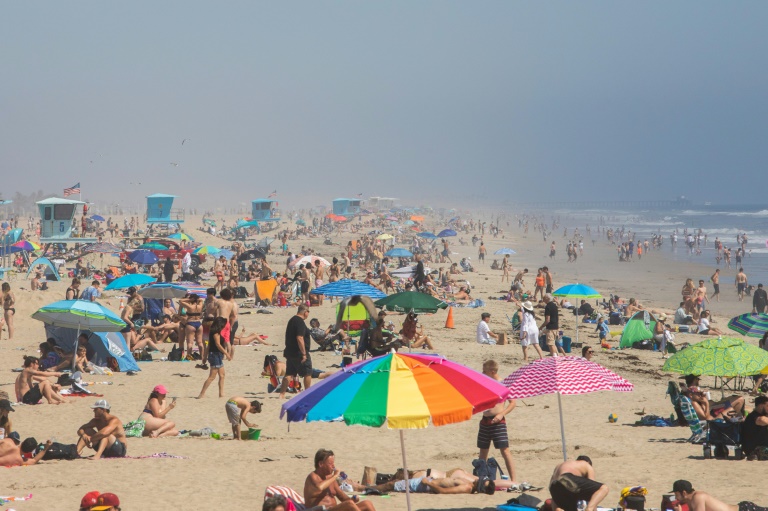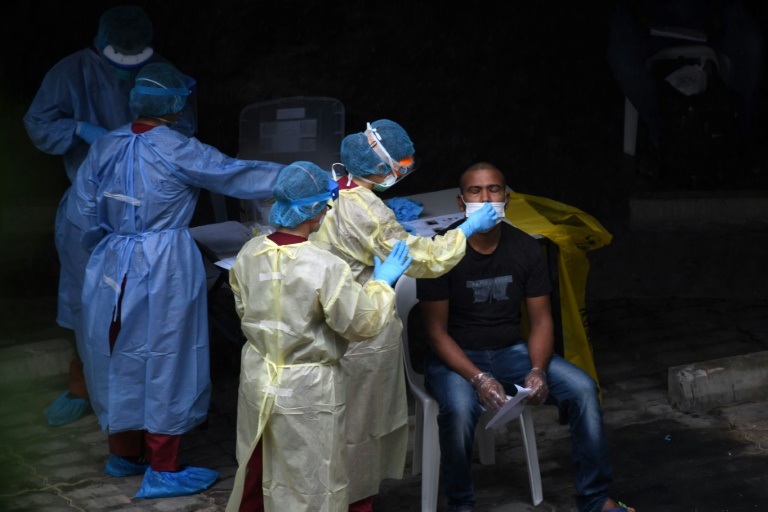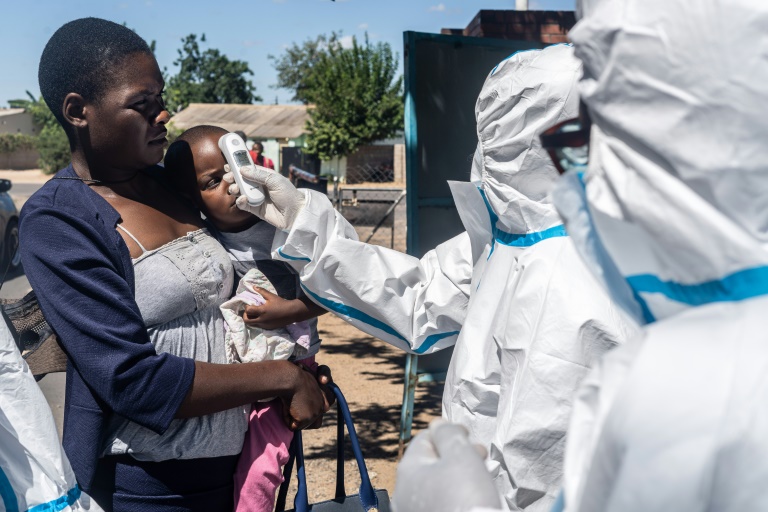Children in China ‘s two most important cities went back to school Monday after more than three months at home, as coronavirus restrictions eased and governments around the world began charting a path out of the pandemic lockdown.
Europe’s four worst-affected countries all reported marked drops in their daily death tolls, offering hope that the outbreak may have peaked in some places — at least for now.
 AFP / JAIME REINAA child plays footbal with his father at Can Pere Antoni Beach in Palma de Mallorca, Spain
AFP / JAIME REINAA child plays footbal with his father at Can Pere Antoni Beach in Palma de Mallorca, SpainBut leaders and experts remain divided on how quickly to revive shuttered economies while maintaining a delicate balance between freedom and safety.
Italy and New York laid out partial reopening plans, with France and Spain to follow suit this week, while tens of thousands of students returned to school in Shanghai and Beijing after months of closures.
 AFP / ADEK BERRYTraffic jam is seen despite the government imposing large-scale social restrictions to curb the spread of the COVID-19 coronavirus in Jakarta
AFP / ADEK BERRYTraffic jam is seen despite the government imposing large-scale social restrictions to curb the spread of the COVID-19 coronavirus in Jakarta“I’m glad, it’s been too long since I’ve seen my classmates,” 18-year-old Hang Huan said in Shanghai. “I’ve missed them a lot.”
“At home, it was difficult to be in front of the computer all day and not very good for learning,” she said.
Shanghai students in their final year of middle and high school were allowed back into their classrooms on Monday, while in Beijing only high school seniors were back on campus, furiously studying for the make-or-break university entrance exam.
 AFP / Anne-Christine POUJOULATA man walks past a mural in Marseille, southern France
AFP / Anne-Christine POUJOULATA man walks past a mural in Marseille, southern FranceStudents must have their temperatures checked at school gates and show “green” health codes on an app that calculates a person’s infection risk, according to China’s Ministry of Education.
Virus numbers in China — where the disease first emerged late last year — have dwindled as the country begins to cautiously lift control measures, although fears remain over a potential resurgence and cases imported from abroad.
– ‘Keep your distance’ –
More than 205,000 coronavirus deaths have been confirmed across the globe — more than a quarter in the United States.
 AFP / Apu GOMESPeople enjoy the sun and sand amid the novel coronavirus pandemic in Huntington Beach, California
AFP / Apu GOMESPeople enjoy the sun and sand amid the novel coronavirus pandemic in Huntington Beach, CaliforniaItaly has the second highest death toll at 26,000, followed by Spain, France and Britain, all at well over 20,000.
But on Sunday Britain’s daily tally was the lowest since March 31, while Italy and Spain’s were the lowest in a month. France’s toll was a drop of more than a third on the previous day’s figures.
Those encouraging figures blew relief through a continent frustrated by restrictions designed to slow the spread of the disease.
 AFP / Tobias SchwarzFace masks are sold in a vending machine in a Berlin subway station
AFP / Tobias SchwarzFace masks are sold in a vending machine in a Berlin subway station“We cannot continue beyond this lockdown — we risk damaging the country’s socioeconomic fabric too much,” said Italian Prime Minister Giuseppe Conte as he unveiled a plan to emerge from Europe’s longest shutdown, in place since early March.
People will have to wear masks in public and rigorously observe social distancing measures when the country’s current restrictions are eased on May 4.
 AFP / Uma Shankar MISHRAHindu devotees bathe in Jabalpur on the occasion of Akshaya Tritiya, a annual spring festival which is believed to bring good luck and success, during the nationwide lockdown in India
AFP / Uma Shankar MISHRAHindu devotees bathe in Jabalpur on the occasion of Akshaya Tritiya, a annual spring festival which is believed to bring good luck and success, during the nationwide lockdown in India“If you love Italy, keep your distance from others,” he said.
Britain’s leader, Boris Johnson, was to return to work on Monday after being hospitalised by COVID-19, one of nearly three million people known to have been infected worldwide.
– Hide and seek –
The pandemic has forced more than half of humanity into lockdowns to stop the virus from spreading — upending lives and tipping the global economy toward a recession not seen in decades.
 AFP / MARCO BERTORELLOA woman donates money after receiving bread during the feast of San Giorgio in Caresana, northern Italy
AFP / MARCO BERTORELLOA woman donates money after receiving bread during the feast of San Giorgio in Caresana, northern ItalyMillions of Muslims are marking a Ramadan like no other — under restrictions for a month of dusk-to-dawn fasting that in happier times involves large family meals.
Saudi Arabia said it would partially lift its curfew but would maintain a round-the-clock lockdown in the Muslim holy city of Mecca.
 AFP / Roslan RAHMANA healthcare worker collects a nasal swab sample from a migrant worker for testing for the COVID-19 novel coronavirus in Singapore
AFP / Roslan RAHMANA healthcare worker collects a nasal swab sample from a migrant worker for testing for the COVID-19 novel coronavirus in SingaporeIn Spain, which has had some of the strictest measures in Europe, children ventured outside for the first time since mid-March on Sunday, some wearing small masks and gloves.
Six-year-old Ricardo said it felt “very good” to be able to run around with his younger sister.
“We played hide and seek, we raced. We found a ladybird that was lost,” he said.
– Vaccine race –
While cases and deaths plateau, the world remains in wait-and-see mode as scientists race to develop treatments and, eventually, a vaccine for the virus.
 AFP / ZINYANGE AUNTONYMedical personnel check temperatures of patients visiting Mpilo Hospital in Bulawayo, Zimbabwe
AFP / ZINYANGE AUNTONYMedical personnel check temperatures of patients visiting Mpilo Hospital in Bulawayo, ZimbabweSome governments are studying measures such as “immunity passports” as one way to get people back to work — but the World Health Organization (WHO) has warned that people who survive COVID-19 cannot be certain they will not be hit again.
Deborah Birx, the doctor who coordinates the US coronavirus response, said the WHO was being “very cautious”.
Several countries, including France and Germany, plan to introduce virus tracing apps to alert users if they are near someone who has tested positive.
 AFP / ALFREDO ESTRELLAHealth workers rest after disinfecting the Angel de la Independencia monument at the Reforma Avenue in Mexico City
AFP / ALFREDO ESTRELLAHealth workers rest after disinfecting the Angel de la Independencia monument at the Reforma Avenue in Mexico CityThe technology has already rolled out in Australia, sparking privacy concerns, and has been widely used in Singapore.
In New York, Governor Andrew Cuomo said a first stage of a reopening would start on May 15 if hospitalisations decrease.
But for some conservative-led states, that timeframe is too long.
Rejecting the advice of top disease experts, the US state of Georgia has allowed thousands of businesses to resume operations, and Oklahoma will let restaurants and cinemas reopen from May 1.
“People are still going to get it. But Oklahomans are safe and we’re ready for a measured reopening,” Governor Kevin Stitt told Fox News.
burs-kaf/hg




